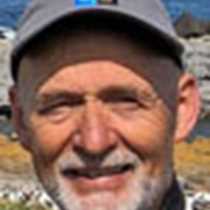Northern Svalbard, 80-81 Degrees North
During the night the National Geographic Explorer pushed east and northwards through calm waters. The earliest risers could see the pack ice edge in the distance. Fortunately the visibility was good, and the morning light was gorgeous. Many guests took advantage of the beautiful colors as they photographed the endless view of drifting pack ice. At 5:30 a.m. a sleeping polar bear was observed just ahead of the ship. Our expedition leader made an exceptionally early wake-up call, and a few minutes later a number of guests came up to the bridge or out on deck to see the bear. We were at 80 degrees 43.06 north. Just before breakfast Captain Oliver spotted a bearded seal on a sheet of ice. Many guests got to see the seal as the ship was gently approaching. Just after breakfast, as one of the naturalists was about to start a talk on Svalbard´s natural history, a second polar bear was spotted. The talk was, of course, put on hold. By noon we had crossed north of 81 degrees, and the pack ice was suddenly covered in fog.
The fog lifted after lunch, and the search for wildlife continued. A young hooded seal, known as a “blueback,” was spotted on an ice floe. Hooded seals are relatively rare in these waters. This animal has a remarkable biology. The young specimen we found seemed to be a year or two old. This species is notable for having an extremely short lactation period. A mother will stay with her pup for only four days, during which the pup drinks more than 10 litres of milk per day and more than doubles its birth mass. Pups gain up to seven kg weight per day! Hooded seals are known to have the fattest milk documented to date among mammals; it can contain up to 70% fat. Females reach sexual maturity at age three; males are a little older when they mature. The hooded seals can live to be 25-30 years old. Hooded seals are protected in Svalbard, although they are still hunted in Canada and Greenland.
What did we learn from our day in the pack ice?
- We found that we needed to pass 80 degrees north to find a continuous edge of pack ice. This situation has dramatically changed over the last decade. Before the turn of the century, concentrations of drifting pack ice could be seen around large parts of the Svalbard archipelago. Today, polar bears are forced to go very far north for the pack ice they need. The bears depend on seals and ice to fulfill their need for fat, and the ice is a necessity for catching seals.
- We saw two polar bears and also various species of seals in their natural habitat.
- We observed a number of seabirds, including the ivory gull. Ivory gulls are icons of the Arctic, and can often be seen sitting next to polar bears, waiting for the leftovers as the bear finishes its meal. We also spotted a long-tailed skua, which is rarely seen in these waters.
- We noticed kittiwakes snapping polar cod between the ice floes as our ship found her way through the outer parts of the pack ice belt. The polar cod is also a very important food source for the seals.
- All in all, we observed some very key elements of the food chain in the waters of the high Arctic.
After lunch, presentations were offered on digital photography and polar bears. At recap, we learned more about seals.
This was our true ice day in the very northernmost waters of Svalbard, which also constitutes the northernmost parts of Norwegian territory. We had reached the northernmost latitude of our expedition, recorded at 81 degrees 11,515 north.
What a day within the true habitat of the polar bear!




